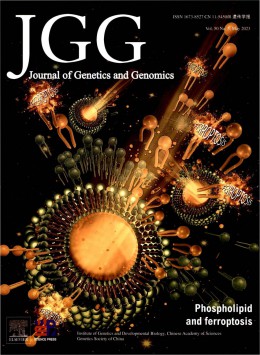Journal of Genetics and Genomics
Journal of Genetics and GenomicsSCI期刊

Journal of Genetics and Genomics学术信息
- 影响因子:0.82
- 发文量:81
- 总被引次数:1511
- 主管单位:中国科学院
- 审稿周期:1-3个月
- 周期:月刊
- 主办单位:中国遗传学会和中国科学院遗传与发育生物学研究所
- 创刊:1974年
- 出版地区:北京
- 国际刊号:1673-8527
- 语言:英语
- 国内刊号:1673-8527
- 类别:医药卫生科技
- 起订时间:
- 咨询邮箱:36706969@qq.com
- 出版社:Journal of Genetics and Genomics
- 邮编:100101
知网收录(中) 维普收录(中) 万方收录(中) CSCD 中国科学引文数据库来源期刊(含扩展版) CA 化学文摘(美) SCI 科学引文索引(美) JST 日本科学技术振兴机构数据库(日) Pж(AJ) 文摘杂志(俄) 国家图书馆馆藏 上海图书馆馆藏 文摘与引文数据库 文摘杂志 医学文摘
中国百种杰出学术期刊,中国期刊方阵双百期刊
人类与医学遗传学动物遗传学植物遗传学微生物遗传学综述

收集需求
确认期刊
支付定金
完成服务
支付尾款
杂志特色CONTRIBUTE
Title page
Include the following information on this page:
• Title The full manuscript title should be succinct, informative and descriptive. The title should include detail for indexing and should be comprehensible for a broad scientific audience. Authors should avoid using nonstandard abbreviations in titles. The title must mention the subject organism (or general group in the case of comparative work). Latin names should be used for all organisms, while common names are allowed for the model systems (rice, maize and yeast).
• Author affiliation Include department, institution, and complete address for each author. If there are authors with different affiliations, use superscripts to match authors with different institutions.
• Corresponding author The name, complete address, telephone and fax numbers, and e-mail address of the corresponding author should be provided.
• Manuscript information The numbers of text pages (including references and figure legends), of figures, of tables, and of words in the paper should be provided.
• Word and character counts The number of words in the abstract and the total number of characters in the paper should be provided.
• Abbreviation footnote List abbreviations in alphabetical order used five or more times . Define these where first mentioned in the text and do not use them in the title.
Abstract and keywords
The abstract should stand on its own with no reference to the text. It should contain approximately 200 words and must summarize the questions being addressed, the approach taken, the major findings, and the significance of the results. It should be concise, complete, and clearly communicate the importance of the work for a broad audience. At least three key words (for the purposes of indexing) should be supplied following the abstract.
Text
Authors should divide their manuscripts into the following sections: Introduction, Results, Discussion, and Materials and methods. Mark every section and every subsection with serial number, like 1., 2., 3., and then 1.1., 1.2., 1.3 and so on.
• Introduction The Introduction should provide the necessary background information for the average reader; it should be both complete and concise. Previous publications that form a basis for the work presented must be cited. Citation of reviews is not a substitute for citing primary research articles. Citation of recent research articles is not a substitute for citing original discoveries. An author’s own work should not be cited preferentially over equally relevant work of others.
• Results The Results should be organized using subheadings to make clear.
• Discussion The Discussion should focus on the interpretation rather than a repetition of the Results section.
• Materials and Methods Methods must be described completely enough so that other laboratories can replicate results and verify claims. Generally, standard procedures should be referenced, though significant variations should be described. Appropriate experimental design and statistical methods should be applied and described wherever necessary for proper interpretation of data and verification of claims. All novel materials and the procedures should be described in sufficient detail to allow their reproduction.
Acknowledgements
List dedications, acknowledgements and funding support.
References
Cite references in the text by name and date of publication, but not by number. Authors are expected to proofread every citation in their reference list against the PDF or photocopy of the cited work so that the reference list is accurate with respect to spellings, symbols, italics, and subscripts/superscripts. Only published or in-press papers and books may be cited in the reference list. Citations for web sites (other than for primary literature) should be handled parenthetically in the text and not included in the reference list. Authors should test all URLs and links.
It is expected that all cited publications have been read and determined to be appropriate by the authors, not merely identified by database searches. Reference to specific results should be to original research articles, not to more recent articles or reviews.
A reference manager software, Endnote, Reference Manager or other similar software, is suggested to be used. Then spelling errors and fault information can be avoided. The reference format is the same as Developmental Biology.
历史收录INDEXED INFORMATION
中文核心期刊要目总览1992199620002004
中国科学引文数据库2011-20122013-20142015-20162017-20182019-20202021-20222023-2024
世界期刊影响力指数报告2021
科学引文索引(美) 20082016201920202023
化学文摘(美)2023
日本科学技术振兴机构数据库(日)2022
文摘杂志(俄)2020
中国科技核心期刊20092010201120122013201420152016201720182019202020212022
统计数据CONTRIBUTE
Journal of Genetics and Genomics杂志学术成果和影响因子
杂志学术成果
杂志影响因子
Journal of Genetics and Genomics杂志年度被引次数报告
2010 2011 2012 2013 2014 2015 2016 2017 2018 2019 2020 2021
本刊文章见刊的年份
在2010年的被引次数
被本刊自己引用的次数
被引次数的累积百分比
本刊文章见刊的年份
在2011年的被引次数
被本刊自己引用的次数
被引次数的累积百分比
本刊文章见刊的年份
在2012年的被引次数
被本刊自己引用的次数
被引次数的累积百分比
本刊文章见刊的年份
在2013年的被引次数
被本刊自己引用的次数
被引次数的累积百分比
本刊文章见刊的年份
在2014年的被引次数
被本刊自己引用的次数
被引次数的累积百分比
本刊文章见刊的年份
在2015年的被引次数
被本刊自己引用的次数
被引次数的累积百分比
本刊文章见刊的年份
在2016年的被引次数
被本刊自己引用的次数
被引次数的累积百分比
本刊文章见刊的年份
在2017年的被引次数
被本刊自己引用的次数
被引次数的累积百分比
本刊文章见刊的年份
在2018年的被引次数
被本刊自己引用的次数
被引次数的累积百分比
本刊文章见刊的年份
在2019年的被引次数
被本刊自己引用的次数
被引次数的累积百分比
本刊文章见刊的年份
在2020年的被引次数
被本刊自己引用的次数
被引次数的累积百分比
本刊文章见刊的年份
在2021年的被引次数
被本刊自己引用的次数
被引次数的累积百分比
服务介绍LITERATURE
免责声明EXPLAIN
本站主要从事期刊咨询服务,不是任何杂志官网,不涉及任何出版事务、本站仅提供有限咨询服务,需要用户自己向出版商投搞且没有绿色通道,是否录用一切以出版商通知为准,本站提供的期刊信息均来源于国家新闻出版总署及网络,仅供参考,提及的第三方名称或商标,其知识产权均属于相应的出版商或期刊,本站与上述机构无从属关系,所有引用均出于解释服务内容的考量,符合商标法规范,本页信息均由法务团队进行把关,若期刊信息有任何问题,请联系我们,我们会认真核实处理。若用户需要出版服务,请联系出版商!

